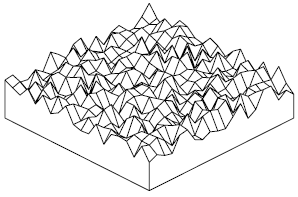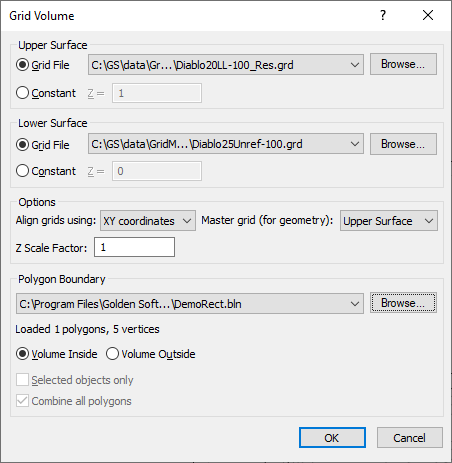Volumes and Areas
The Grids | Calculate | Volume command is used to compute net volumes, cut and fill volumes, planar areas, and surface areas. The computation results are displayed in the grid volume report. The results can be saved as an ASCII text file, in Rich Text Format, or can be pasted into the clipboard.
Volume calculations are performed on solids defined by an upper and lower surface or 3D polygons. The upper and lower surfaces are defined by a grid file or a plane of constant Z level. The upper surface does not have to be above the lower surface at all points; the upper surface may dip below the lower surfaces in some locations. NoData regions on either the upper or the lower surface are excluded from consideration during the volume calculations.
If the upper and lower surface grid files do not have the same number of rows and columns or the same XY limits, the selected master file determines the geometry for the volume calculations. Surfer matches the input grids by their XY coordinates and performs the calculations on the overlapping nodes.
Volume results are provided in cubic units based on the units of the input grid file.
Volume Accuracy Example
Volume calculations are generated for each grid cell. In areas where the surface is tilted at the top or bottom of a grid cell, Surfer approximates the volume of the prism at the top or bottom of the grid cell column. For very coarse grids, the prisms can contain a significant volume. Volume calculations become more accurate as the density of the grid is increased because the relative size of the prisms is reduced compared to the size of the associated column. Grids with significant "noise" or with highly irregular surfaces are poor candidates for volume calculations.
|
|
|
This grid has a highly irregular surface and is a poor candidate for volume calculations. |
|
|
|
These two grids are based on the same data but created at different grid densities. The grid on the right is a better candidate for obtaining accurate volume information because it is a much more smooth and dense grid. |
To Calculate Volumes and Areas
Use the Grids | Calculate | Volume command to calculate net volumes, cut and fill volumes, planar areas, surface areas, and 3D polygon volumes.
- Click the Grids | Calculate | Volume command or the
 button.
button. - Specify the Upper Surface and Lower Surface parameters, or for 3D polygon volumes specify a file in Upper Surface and a file for Polygon Boundary. See the Grid Volume Dialog section below for instructions on Polygon Boundary.
- The Grid File option is used to specify a grid to use as the upper or lower surface. Specify the source map layer or grid file in the Grid File section. Click the current selection and select a map layer from the list. Only map layers created from grid files are included in the Grid File list. Click Browse to load a grid file with the Open Grid dialog.
- The Constant option is used to specify the level of the planar surface to use as the upper or lower surface. Specify the level of the planar surface by entering the value into the Z = box. The specified value is in Z data units.
- In the Options section Align grids using list, select Node position if the upper and lower grid files have the same number of rows and columns or select XY coordinates if they do not. If XY coordinates was selected, also select a value from the Master grid (for geometry) list. Select either the upper or lower grid file to be the base geometry for the calculation.
- If the X, Y, and Z units are different, the resulting volume calculations are meaningless. If, for example, your XY values are in meters but your Z values are in feet, the volume results are square meters times feet, rather than cubic units. In the Options section, Z Scale Factor can be used to adjust for this problem. In this example, setting the Z Scale Factor to 0.3048 (number of meters in a foot) results in cubic meters for volume calculations. You will need to know the conversion factor to use this field.
- Click OK in the Grid Volume dialog and the results are displayed in a report.
- Click File | Save As to save the report, or you can copy the information to the clipboard and paste it into another application.
Use the Grids | Calculate | Volume command to calculate net volumes, cut and fill volumes, planar areas, and surface areas.
Grid Volume Dialog
Click the Grids | Calculate | Volume command to open the Grid Volume dialog.
|
|
|
Specify grid volume options in the Grid Volume dialog. |
Upper Surface and Lower Surface
Specify the upper surface in the Upper Surface section, and specify the lower surface in the Lower Surface section. The surfaces can be grid files or constant planar surfaces.
Grid File
The Grid File option is used to specify a grid to use as the upper or lower surface. Specify the source map layer or grid file in the Grid File section. Click the current selection and select a map layer from the list. Only map layers created from grid files are included in the Grid File list. Map layers will be displayed from all open plot documents. Click Browse to load a grid file with the Open Grid dialog.
Constant Z
The Constant option is used to specify the level of the planar surface to use as the upper or lower surface. Specify the level of the planar surface by entering the value into the Z = box. The specified value is in Z data units.
Align Grids
If the input grid files have the same number of rows and columns, select the Node position value from the Align grids using list. The volume calculation will be performed in equivalent grid nodes, regardless of the X and Y values. If the input grid files do not have the same number of rows and columns, select the XY coordinates value from the Align grids using list to match the input grid files on X and Y values.
If Align grids using is set to XY coordinates and all grids are referenced but in a different coordinate system, the calculation uses the master grid's coordinate system. If an input grid files is not referenced but another grid file is referenced, Surfer displays a warning about mixing referenced and unreferenced grid files. Selecting Yes continues with the volume calculation, but none of the other grids will be projected to the master grid's coordinate system. If the grids are in the same coordinate system, selecting Yes will perform the calculation as expected. However, if a grid is not referenced and not in the same coordinate system, select No at the warning to cancel the calculation and return to the Grid Volume dialog. Select different grid files with referenced or matching coordinate systems or use the Grids | Edit | Assign Coordinate System to change the coordinate system of one or more of the grid files.
Master Grid
From the Master grid (for geometry) list, select Upper Surface or Lower Surface as the master grid to use for the base geometry for the volume calculation.
Z Scale Factor
If the X, Y, and Z units are different, the resulting volume calculations are meaningless. If, for example, your X, Y values are in meters but your Z values are in feet, the volume results are square meters times feet, rather than cubic units. Z Scale Factor can be used to adjust for this problem. In this example, setting the Z Scale Factor to 0.3048 (number of meters in a foot) results in cubic meters for volume calculations. You will need to know the conversion factor to use this field.
A grid with X, Y, and Z units in feet, the units for the results are: Net Volume = (feet * feet * feet) or ft3.
Polygon Boundary
Calculate the volume inside or outside a specific region by specifying a Polygon Boundary map layer or vector file. Specify the source map layer or vector file in the Polygon Boundary section. Click the current selection and select a base layer from the list. Base layers will be displayed from all open documents. Click Browse to load a vector file with the Open dialog. When the base layer or vector file includes more than one polygon/3D polygon, the volume is calculated inside or outside all of the polygons/3D polygons in the layer or file. The number of polygons and number of vertices in the base layer or vector file is displayed below the Polygon Boundary field.
The following vector file types are supported in the Polygon Boundary field:
Volume Inside or Volume Outside
Click Volume Inside to calculate the volume inside of the polygon(s) or 3D polygon(s) in the base layer or vector file. Click Volume Outside to calculate the volume outside of the polygon(s) or 3D polygon(s) in the base layer or vector file.
Selected Objects Only
Check the Selected objects only check box to use only the selected objects in the base layer to calculate volumes. The Loaded polygons and vertices values are updated when the Selected objects only box is checked. Select a base layer in the Polygon Boundary field to use the Selected objects only option. The Selected objects only option is not available when the Polygon Boundary is a vector file. The polygon or polygons must be selected before clicking the Grids | Calculate | Volume command.
Combine All Polygons
Select Combine all polygons to add all the statistics for the total number of polygons. If there is only one polygon in the map, the box is checked by default and Combine all polygons is not active. When Combine all polygons is unchecked, the report presents statistics for each individual polygon.
Grid Report
Click OK in the Grid Volume dialog and the results are displayed in the Grid Volume Report. Use File | Save As to save the report, or you can copy the information to the clipboard and paste it into another application.
See Also
Introduction to Volumes, Areas, Cross Sections
Calculating the Volume of a Lake
Calculating the Volume of a Grid with NoData values


